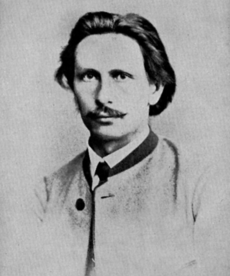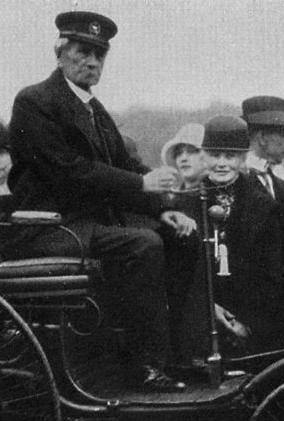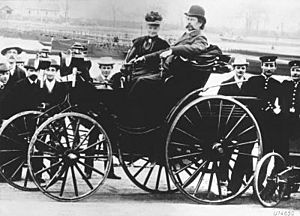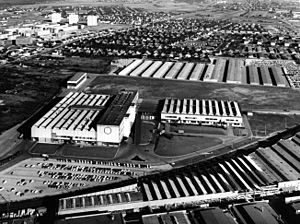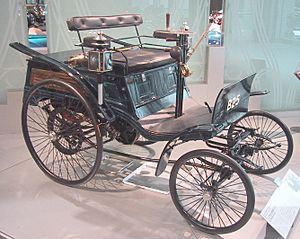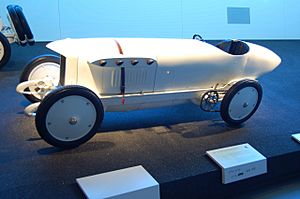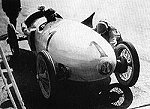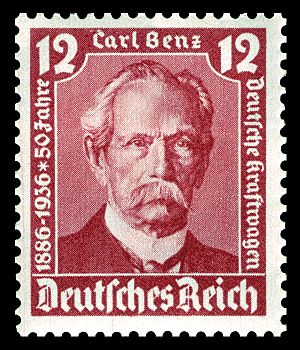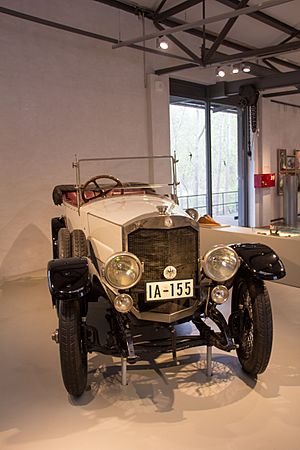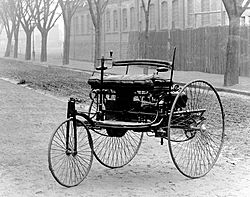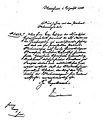Karl Benz facts for kids
Quick facts for kids
Karl Benz
|
|
|---|---|
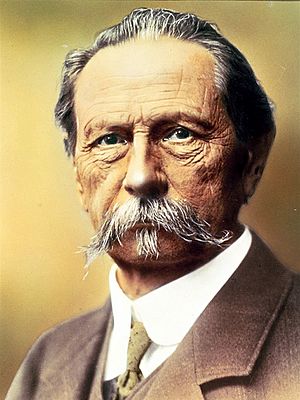 |
|
| Born | November 25, 1844 |
| Died | April 4, 1929 (aged 84) Ladenburg, Germany
|
| Nationality | German |
| Education | University of Karlsruhe |
| Spouse(s) | Bertha Ringer |
| Children | 5, Eugen, Richard, Clara, Ellen, Thilde |
| Parent(s) | Johann George Benz (father), Josephine Vaillant (mother) |
| Signature | |
 |
|
Karl Friedrich Benz (born November 25, 1844 – died April 4, 1929) was a German engineer. He is often called the inventor of the first car powered by gasoline. Along with his wife, Bertha Benz, he helped start the famous car company Mercedes-Benz.
Contents
Karl Benz's Early Life
Karl Benz was born in Mühlburg, which is now part of Germany. His parents were Josephine Vaillant and Johann Georg Benz, a train driver. Even though his family didn't have much money, his mother worked hard to make sure he got a good education.
Karl was a very smart student. At nine years old, he started at a science-focused school called the Lyceum. Later, he studied at the University of Karlsruhe, learning about engineering.
Karl first thought about becoming a locksmith. But he soon decided to follow his father's path into engineering. When he was 15, he passed the entrance exam for mechanical engineering at the University of Karlsruhe. He graduated at 19 years old in 1864.
During these years, while riding his bicycle, he started to imagine a vehicle that didn't need horses. This idea would later become the car. After college, Karl worked at several companies for seven years. He gained a lot of experience, but he didn't quite fit in anywhere.
Building His First Factory and Inventions
In 1871, when he was 27, Karl Benz started a company with August Ritter in Mannheim. It was called the Iron Foundry and Mechanical Workshop. The first year was very tough. Ritter turned out to be unreliable, and the company's tools were taken away because of debt.
But Karl's fiancée, Bertha Ringer, saved the business. She used her own money to buy out Ritter's share. Karl Benz and Bertha Ringer got married on July 20, 1872. They had five children: Eugen, Richard, Clara, Thilde, and Ellen.
Even with business problems, Karl Benz focused on inventing new engines. To earn more money, he started working on new patents in 1878. He worked hard to create a reliable two-stroke engine that ran on petrol. He finished it on New Year's Eve, 1878, and got a patent for it in 1879.
Karl Benz was a true genius. He patented many other important parts for his engine. These included the system to control speed, the ignition (which uses sparks from a battery), the spark plug, the carburetor, the clutch, the gear shift, and the water radiator. These inventions were very important for future cars.
Karl Benz loved his hobby of working with bicycles. This led him to a bicycle repair shop in Mannheim. In 1883, he teamed up with the shop owners, Max Rose and Friedrich Wilhelm Eßlinger. They started a new company called Benz & Companie Rheinische Gasmotoren-Fabrik, often called Benz & Cie. The company grew quickly and started making gas engines.
The success of Benz & Cie. allowed Karl to follow his dream of building a "horseless carriage." He used ideas from bicycles to create his first automobile. It had wire wheels, unlike the wooden wheels of horse carriages. It had a four-stroke engine he designed, placed between the rear wheels. It also had an advanced ignition system and used water to cool the engine. Power went to the rear wheels using two chains. Karl Benz finished his invention in 1885 and called it the "Benz Patent Motorwagen."

This was the first car ever designed to power itself. It wasn't just a horse carriage with an engine added. Because of this, Karl Benz received a patent for it and is known as the inventor of the modern car.
The Motorwagen received its patent on January 29, 1886. The first version was hard to control. During a public test, it even crashed into a wall! But Karl kept working on it. Successful tests on public roads happened in the summer of 1886. In 1887, he made the Motorwagen Model 2 with improvements. In 1889, he introduced the Model 3, which had wooden wheels and was shown at the Paris Expo.
Benz started selling the vehicle in late 1888. This made it the first car ever sold to the public. The early 1888 Motorwagen didn't have gears, so it couldn't go up hills easily. This problem was fixed thanks to Bertha Benz.
Bertha Benz's Amazing Road Trip
A very important part of the Benz story is the first long-distance car trip. Bertha Benz, Karl's wife, took the car without telling him. On the morning of August 5, 1888, she drove the Motorwagen about 106 kilometers (60 miles). She went from Mannheim to Pforzheim to visit her mother. Her sons, Eugen and Richard, went with her.
During the trip, she had to find pharmacies to buy fuel (which was a type of cleaning fluid). She also fixed several problems with the car. When the brakes started to wear out on long downhill slopes, she found a shoemaker. She asked him to nail leather onto the brake blocks, inventing the first brake linings!
Bertha and her sons finally arrived at night. She sent a telegram to Karl to tell him about their amazing journey. Her goal was to show everyone that the Benz Motorwagen could be used for travel. She also wanted to get people excited about the car. Today, this historic trip is celebrated every two years in Germany with an antique car rally.
In 2008, the Bertha Benz Memorial Route became an official route of industrial heritage. It follows Bertha Benz's exact path from 1888. Now, anyone can follow the 194-kilometer (120-mile) signposted route. It goes from Mannheim through Heidelberg to Pforzheim and back.
Benz's Model 3 was shown to the world at the 1889 World's Fair in Paris. About 25 Motorwagens were built between 1886 and 1893.
Growth of Benz & Cie.
There was a big demand for Karl Benz's engines. This meant he had to make his factory in Mannheim bigger. In 1886, a new building was added. Benz & Cie. grew from 50 employees in 1889 to 430 employees in 1899.
By the end of the 1800s, Benz was the largest car company in the world. In 1899, they produced 572 cars.
The Benz Velo car also took part in the world's first car race, the 1894 Paris to Rouen. In 1895, Benz designed the first truck in history. Some of these trucks were later changed to become the first motor buses.
In 1896, Karl Benz received a patent for his design of the first flat engine. This special engine design is still used today by companies like Porsche and Subaru. It's also used in some high-performance racing cars.
Karl Benz was recognized for his achievements. He was added to the Automotive Hall of Fame in 1984. His sons, Eugen and Richard, left Benz & Cie. in 1903. But Richard came back in 1904 to design passenger cars.
In that year, Benz & Cie. sold 3,480 cars. The company remained a top car maker.
On November 25, 1914, Karl Benz turned 70. His old university, the Karlsruhe University, gave him an honorary doctorate degree. He became known as Dr. Ing. h. c. Karl Benz.
Almost from the start of car production, car companies used sports car racing to get attention. At first, regular production cars were raced. The Benz Velo raced in the first car race from Paris to Rouen in 1894.
Later, companies started building special racecars. Winning races helped sell more cars because people connected the car's name with success. One unique race car was the Benz Tropfenwagen (teardrop car). It was the first car with a mid-engine and a special aerodynamic shape. It was shown at the 1923 European Grand Prix.
Death
Karl Benz passed away at his home in Ladenburg on April 4, 1929. He was 84 years old and died from a lung illness. His wife, Bertha Benz, continued to live in their home until her death in 1944. Their family lived in the house for another 30 years.
Today, the Benz home is a historic site. It is used by a non-profit group called the Gottlieb Daimler and Karl Benz Foundation. This foundation honors both Bertha and Karl Benz for their important roles in the history of cars.
| Three wheels | |
|---|---|
| Tubular steel frame | |
| Steering with a handle, connected to the front wheel | |
| Electric ignition | |
| Gears at the back (for engine valves) | |
| Water-cooled engine | |
| Gasoline four-stroke engine, placed flat | |
| One cylinder, Bore 116 mm, Stroke 160 mm | |
| Patent model: 958 cc, 0.8 hp, 16 km/h (about 10 mph) | |
| Commercial model: 1600 cc, ¾ hp, 13 km/h (about 8 mph) | |
Related pages
Images for kids
-
The Benz Patent-Motorwagen Number 3 from 1888, used by Bertha Benz for the first long-distance car journey.
See also
 In Spanish: Carl Benz para niños
In Spanish: Carl Benz para niños


